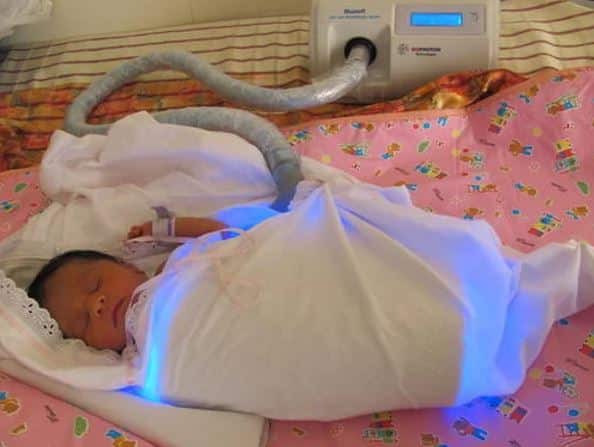Neonatal jaundice, also known as infant jaundice is a yellow discoloration of a newborn baby’s skin and eyes due to high levels of bilirubin. Other symptoms include excess sleepiness and poor feeding.
Bilirubin is a yellow substance that comes from the breakdown of red blood cells and is excreted by the liver.
Infant jaundice is normal in full-term babies as there is a breakdown of fetal hemoglobin and is replaced with adult hemoglobin. Also, the liver is relatively immature and tends to excrete bilirubin slowly.
In preterm babies, jaundice may require the need for treatment to prevent complications such as seizures, cerebral palsy and rarely kernicterus, a bilirubin-induced brain dysfunction.
Neonatal jaundice treatment may include more frequent feeding, phototherapy, or exchange transfusions.
Causes of Neonatal Jaundice
Jaundice is a result of excess bilirubin (hyperbilirubinemia). Bilirubin, which is responsible for the yellow color of jaundice, is a normal part of the pigment released from the breakdown of red blood cells.
Newborns produce more bilirubin than adults do because of greater production and faster breakdown of red blood cells in the first few days of life. Normally, the liver filters bilirubin from the bloodstream and releases it into the intestinal tract.
A newborn’s immature liver often can’t remove bilirubin quickly enough, causing an excess of bilirubin. Jaundice due to these normal newborn conditions is called physiologic jaundice, and it typically appears on the second or third day of life.
Other causes
An underlying disorder may cause infant jaundice. In these cases, jaundice often appears much earlier or much later than does the more common form of infant jaundice. Diseases or conditions that can cause jaundice to include:
- Internal bleeding (hemorrhage)
- An infection in your baby’s blood (sepsis)
- Other viral or bacterial infections
- An incompatibility between the mother’s blood and the baby’s blood
- A liver malfunction
- Biliary atresia, a condition in which the baby’s bile ducts are blocked or scarred
- An enzyme deficiency
- An abnormality of your baby’s red blood cells that causes them to break down rapidly
Neonatal Jaundice Treatment
Mild infant jaundice often disappears on its own within two or three weeks. Treatments to lower the level of bilirubin in an infant’s blood may include:
Enhanced nutrition – To prevent weight loss, your doctor may recommend more-frequent feeding or supplementation to ensure that your baby receives adequate nutrition.
Phototherapy – This refers to light therapy to treat neonatal jaundice.
The bilirubin levels for the initiative of phototherapy vary depending on the age and health status of the newborn. However, any newborn with total serum bilirubin greater than 359 μmol/l ( 21 mg/dL) should receive phototherapy.
The light changes the shape and structure of bilirubin molecules in such a way that they can be excreted in both the urine and stool.

The phototherapy involved is not ultraviolet light therapy but rather a specific frequency of blue light. The light can be applied with overhead lamps, which means that the baby’s eyes need to be covered, or with a device called a biliblanket, which sits under the baby’s clothing close to its skin.
Exchange transfusions – This involves repeatedly withdrawing small amounts of blood and replacing it with donor blood, thereby diluting the bilirubin and maternal antibodies — a procedure that’s performed in a newborn intensive care unit.
Rarely, when severe jaundice doesn’t respond to other treatments, a baby may need an exchange transfusion of blood. It should be used for any newborn with total serum bilirubin of greater than 428 μmol/l ( 25 mg/dL ).
